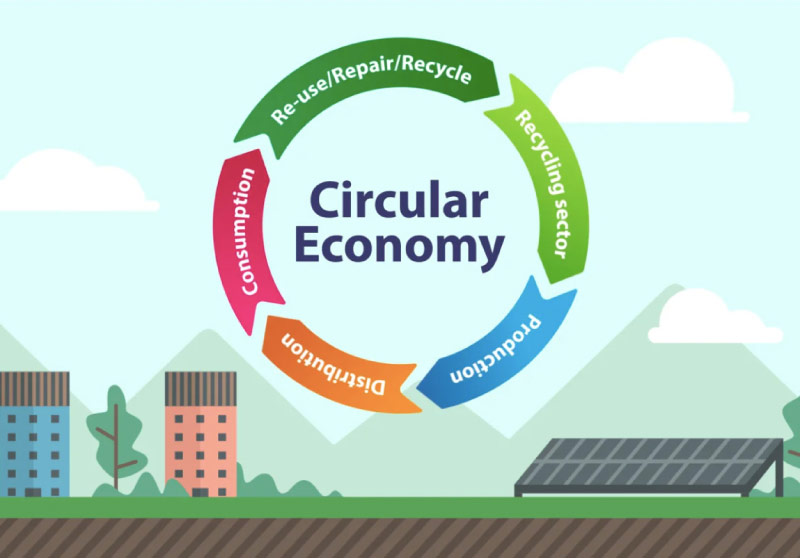Sunday Apr 20, 2025
Sunday Apr 20, 2025
Friday, 4 June 2021 00:00 - - {{hitsCtrl.values.hits}}

If you are an individual who is part of any organisation that manufactures a product purchased by customers, it is time that you paused and thought how you and the company you work for can better innovate and join the journey towards a more circular economy
 First held in 1974, World Environment Day is a day where there is greater focus on increasing awareness and action for the protection of the environment. This year’s World Environment Day is focused on Ecosystem Restoration.
First held in 1974, World Environment Day is a day where there is greater focus on increasing awareness and action for the protection of the environment. This year’s World Environment Day is focused on Ecosystem Restoration.
While the obvious and most straightforward approach to support this year’s theme is to literally restore an ecosystem by bringing it back to life or protecting wilderness and nature, there are other indirect but important actions recommended by The Geneva Environment Network, one of which is “halting purchases of products and services that are not certified as sustainable”.
Over the past few years, there has been a significant shift in the fashion industry’s mindset towards sustainability. The industry is of the notion that sustainability is the key to growth and brand identity, and an increasingly basic expectation of customers.
In the face of the COVID-19 pandemic raging across the world, sustainability has also stood out as a key strategy for brand resilience and survival through the prevailing challenges of today. It is well accepted that the consumer focus on sustainability will only intensify in the post COVID-19 world.
At Hela Clothing we know that our investment in greater sustainability will help fuel our growth. It plays a key role in our plans for the future and is incorporated into every aspect of our business. This year alone we received two awards – beating out other global manufacturers – from major UK supermarkets Asda and Tesco for our various sustainability initiatives. And now that we have spent the past five years laying down the necessary foundation to make sustainability an integral aspect of the business, we are focusing on how we can further elevate our sustainability program over the next five to 10 years.
Hela Clothing is already a net exporter of renewable energy at four of our factories, generating on average 104% of our electricity requirement for these factories through solar panels, while a 51% reduction in electricity consumption and a 35% reduction in water consumption across the Group have also been successfully achieved. We produce clothing from advanced materials such as sustainably-produced organic cotton, seaweed and recycled plastic. However, for all of us, this is just the beginning, as we are actively developing exciting new partnerships with some of the world’s leading brands to collaborate on making further progress towards deeper sustainability and true circularity.
The fashion industry is embracing an approach that reduces the impact on the environment to reap greater benefits for business, communities and the world. Today’s consumers are increasingly more concerned about sustainability issues and as a result, the term “circularity” has become a buzzword in the industry. It is a commonly-held belief that increased circularity will be an important part of a more sustainable future and it’s important to understand how it actually benefits the world’s ecosystems.
Natural resources move in a circle, being reused again and again, with minimal waste and environmental harm from further resource extraction, production and disposal. This means less new resources need to be taken from nature, and there is less pollution and waste, thereby making it easier to protect, restore and preserve ecosystems.
While the concept of circularity may seem simple in principle, actually achieving this in today’s highly-complex global economy, and still providing the advanced and often exotic goods and services people expect from it is far from simple. It involves the use of regenerative designs, materials and processes, including the energy and water used to manufacture and transport them.
There is a greater focus on products being manufactured with fewer raw materials and less pollution, and the materials being maximally reused in products through circular recycling and reuse. It involves communities, partnerships, innovation and collaboration. Circularity is widely considered an important strategy for a more sustainable apparel sector, today and tomorrow. However, circular fashion requires unprecedented collective effort and collaboration across the entire value chain to succeed.
Over the years, sustainability professionals like myself have been guided and inspired by the vision of pioneering thought leaders such as Amory and Hunter Lovins and Paul Hawken (Natural Capitalism, Rocky Mountain Institute), Bill McKibben (Deep Economy), Walter Stahel (Performance Economy), and William McDonough and Michael Braungart (Cradle to Cradle).
Today, organisations like The Ellen MacArthur Foundation, the World Economic Forum’s Platform for Accelerating the Circular Economy (PACE), and Circle Economy are working with the private sector to support innovation. In the apparel sector, organisations like Fashion for Good and the Global Fashion Agenda are supporting innovation, as leading brands and manufacturers are now looking seriously at their supply chains and products with a new circular eye.
If you are a consumer who wants to act in a sustainable manner and help in the efforts to protect the environment, on this World Environment Day, it is imperative that you think about how the products you use are made, and where they come from. Before purchasing any item you should stop and think if they are made sustainably, whether they can be recycled and reused without causing more damage to our natural environment and wildlife and if you are supporting companies that are producing truly sustainable products.
If you are an individual who is part of any organisation that manufactures a product purchased by customers, it is time that you paused and thought how you and the company you work for can better innovate and join the journey towards a more circular economy. It is an exciting journey towards a future that involves innovation, collaboration, partnerships, and people.
(The writer is General Manager – Engineering & Sustainability at Hela Clothing. In a career spanning over 20 years, he has worked in environmental sustainability and renewable energy in diverse roles in the private, non-profit, and government sectors around the world, including as a Presidential Management Fellow at the US Department of Energy in the Office of Energy Efficiency and Renewable Energy. He can be reached via [email protected])